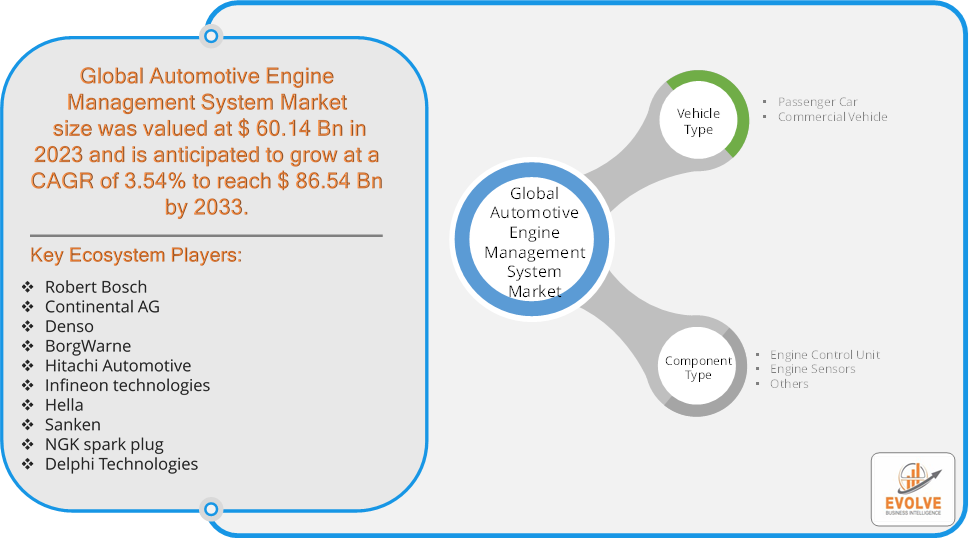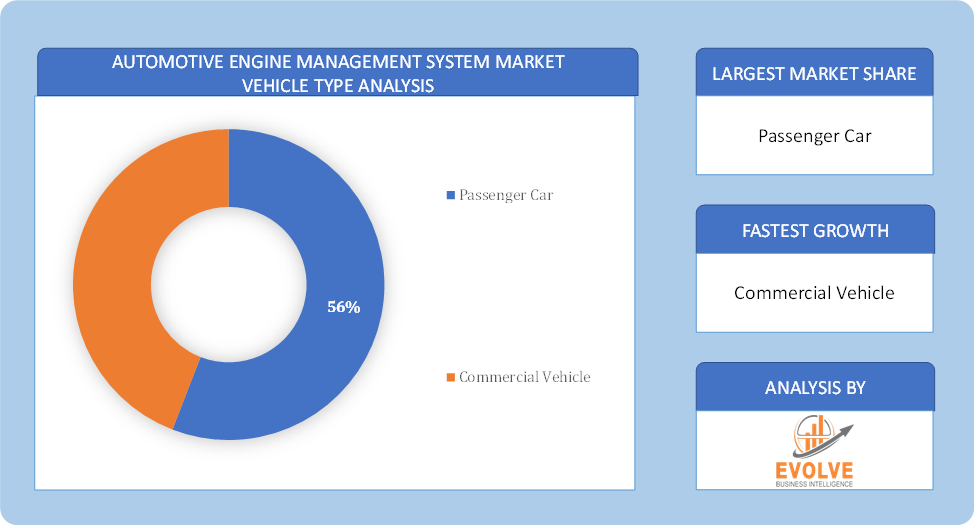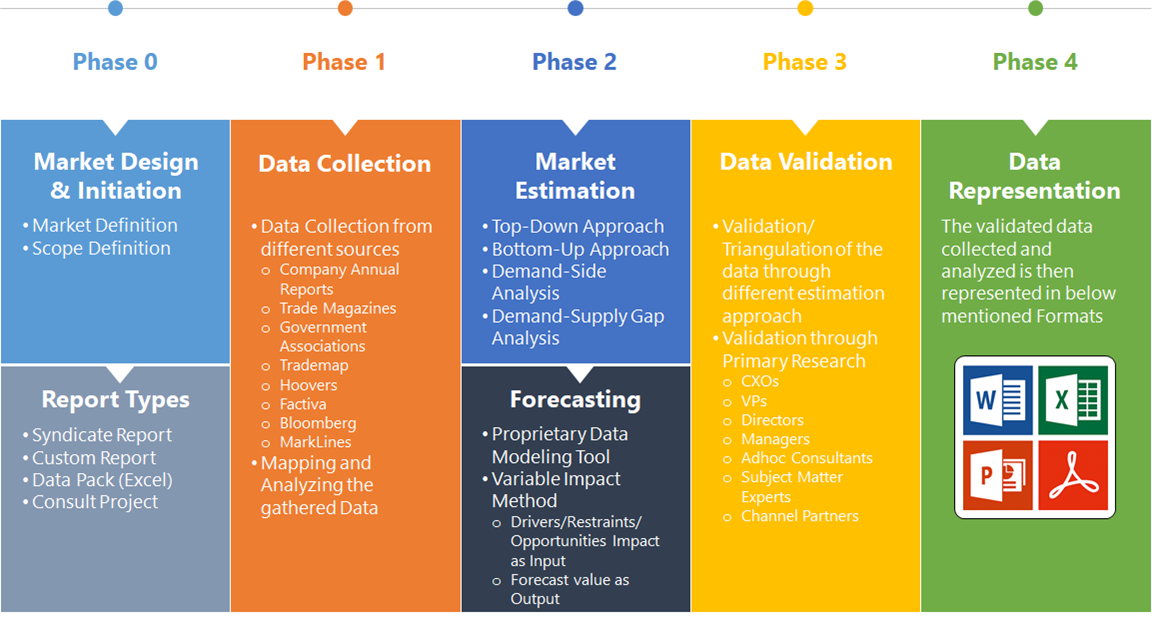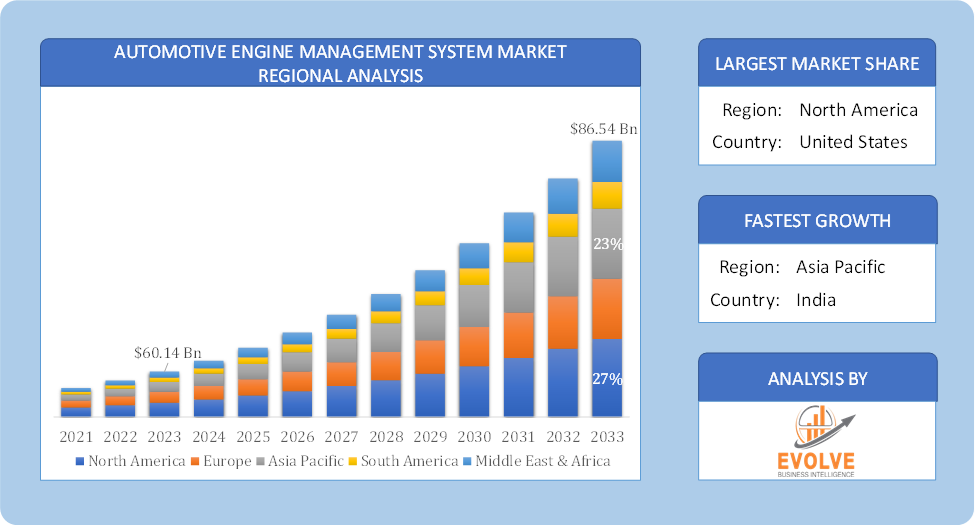Automotive Engine Management System Market Analysis and Global Forecast 2023-2033
$ 1,390.00 – $ 5,520.00Price range: $ 1,390.00 through $ 5,520.00
Automotive Engine Management System Market Research Report: Information By Vehicle Type (Passenger Car, Commercial Vehicle), By Component Type (Engine Control Unit, Engine Sensors, Others), and by Region — Forecast till 2033
Page: 169
Automotive Engine Management System Market Overview
The Automotive Engine Management System Market Size is expected to reach USD 86.54 Billion by 2033. The Automotive Engine Management System Market industry size accounted for USD 60.14 Billion in 2023 and is expected to expand at a compound annual growth rate (CAGR) of 3.54% from 2023 to 2033. The Automotive Engine Management System Market refers to the global market for systems that manage and control the operation of an internal combustion engine in a vehicle. These systems are designed to enhance engine performance, improve fuel efficiency, reduce emissions, and ensure smooth and reliable engine operation. The market includes various components and technologies used in engine management systems, such as sensors, actuators, engine control units (ECUs), fuel injectors, ignition systems, and software.
The Automotive Engine Management System Market is poised for growth due to the ongoing advancements in automotive technology, rising environmental concerns, and the continuous evolution of emission regulations globally.
Global Automotive Engine Management System Market Synopsis
 COVID-19 Impact Analysis
COVID-19 Impact Analysis
The COVID-19 pandemic had a significant impact on the Automotive Engine Management System Market. Lockdowns and restrictions led to the temporary closure of manufacturing plants, causing delays in the production and supply of automotive engine management system components. Global supply chains were disrupted, affecting the availability of raw materials and components. This caused delays and increased costs for manufacturers. There has been a shift in consumer preferences towards more cost-effective and fuel-efficient vehicles, which could drive demand for advanced engine management systems. The pandemic has accelerated the adoption of digital and remote technologies in manufacturing processes, leading to potential innovations in engine management systems. The pandemic has accelerated the shift towards electric vehicles (EVs). While EVs have different engine management requirements, the development of advanced management systems for hybrid and electric powertrains will be crucial.
Automotive Engine Management System Market Dynamics
The major factors that have impacted the growth of Automotive Engine Management System Market are as follows:
Drivers:
Ø Advancements in Automotive Technology
Continuous advancements in automotive technology, such as the integration of advanced sensors, actuators, and control algorithms, are driving the demand for sophisticated engine management systems. These technologies enhance vehicle performance, fuel efficiency, and emissions control. Automakers are increasingly focusing on improving vehicle performance and reliability. Advanced engine management systems help achieve these goals by ensuring optimal engine operation under various driving conditions. The trend towards connected and autonomous vehicles is driving the integration of sophisticated engine management systems that can communicate with other vehicle systems and external infrastructure. This connectivity improves overall vehicle performance and efficiency.
Restraint:
- Perception of High Development and Manufacturing Costs
The development and manufacturing of advanced engine management systems involve significant investment in research and development, advanced materials, and sophisticated manufacturing processes. These high costs can be a barrier for manufacturers, particularly in price-sensitive markets. Rapid advancements in automotive technology can render existing engine management systems obsolete. Manufacturers must continuously innovate and update their systems to stay competitive, which can be resource-intensive and financially burdensome.
Opportunity:
⮚ Adoption of Electric and Hybrid Vehicles
As the automotive industry shifts towards electrification, there is a growing need for advanced engine management systems tailored for hybrid and electric vehicles. These systems can optimize the performance of both internal combustion engines and electric powertrains, presenting a significant opportunity for market growth. Increasing awareness of environmental issues and the push for sustainable transportation solutions are driving demand for engine management systems that reduce emissions and improve fuel efficiency. Companies that focus on developing eco-friendly technologies will find significant growth opportunities.
Automotive Engine Management System Market Segment Overview
 By Vehicle Type
By Vehicle Type
Based on Vehicle Type, the market is segmented based on Passenger Car and Commercial Vehicle. Passenger cars segment dominated the market in 2022. As vehicle ownership increases globally, OEMs are developing several engines based on various types of passenger car sectors. Multi-fuel engines, Variable Valve Technology (VVT), turbocharger technology, and Common Rail Direct Injection (CRDI) are just a few of the engine developments in the automobile industry that deliver the high power and torque needed for luxury category vehicles.
By Component Type
Based on Component Type, the market segment has been divided into the Engine Control Unit, Engine Sensors and Others. Engine control unit (ECU) segment dominated the Automotive Engine Management System market. These sensors are important for keeping an eye on several engine-related characteristics, including pressure, temperature, airflow, and oxygen levels. Every sensor has a distinct purpose that enhances the engine’s efficiency and performance. In contrast, a car usually has a single ECU that processes the information from the sensors and modifies the engine in real-time to maximize performance.
Global Automotive Engine Management System Market Regional Analysis
Based on region, the global Automotive Engine Management System Market has been divided into North America, Europe, Asia-Pacific, the Middle East & Africa, and Latin America. North America is projected to dominate the use of the Automotive Engine Management System Market followed by the Asia-Pacific and Europe regions.
 Automotive Engine Management System North America Market
Automotive Engine Management System North America Market
North America holds a dominant position in the Automotive Engine Management System Market. The North American market is characterized by stringent emission standards and a high adoption rate of advanced automotive technologies and growth in electric and hybrid vehicle adoption, and advancements in autonomous driving technologies.
Automotive Engine Management System Asia-Pacific Market
The Asia-Pacific region has indeed emerged as the fastest-growing market for the Automotive Engine Management System Market industry. The Asia-Pacific region is the fastest-growing market, driven by large-scale vehicle production and sales in countries like China, India, and Japan. Rapid urbanization, increasing disposable incomes, and supportive government policies for automotive sector growth and huge potential in emerging markets, increasing demand for fuel-efficient and low-emission vehicles, and growth in electric vehicle adoption.
Competitive Landscape
The global Automotive Engine Management System Market is highly competitive, with numerous players offering a wide range of software solutions. The competitive landscape is characterized by the presence of established companies, as well as emerging startups and niche players. To increase their market position and attract a wide consumer base, the businesses are employing various strategies, such as product launches, and strategic alliances.
Prominent Players:
- Robert Bosch
- Continental AG
- Denso
- BorgWarne
- Hitachi Automotive
- Infineon technologies
- Hella
- Sanken
- NGK spark plug
- Delphi Technologies
Key Development
In February 2024, Maruti Suzuki took advantage of the Bharat Mobility Expo 2024 stage to demonstrate the Wagon R Flex Fuel’s potential. Following its debut at the 2023 Auto Expo in Delhi, the Wagon R Flex Fuel is expected to hit the streets before the end of the year.
In December 2021, Dover Corp. introduced the new DMP Magnetostrictive Flex Probe, a fuel management device that provides exact measurements of fuel and other tank liquids. The new device is compatible with all other probes and consoles in the DFS product line, making it simple to combine with current fuel management solutions.
Scope of the Report
Global Automotive Engine Management System Market, by Vehicle Type
- Passenger Car
- Commercial Vehicle
Global Automotive Engine Management System Market, by Component Type
- Engine Control Unit
- Engine Sensors
- Others
Global Automotive Engine Management System Market, by Region
- North America
- US
- Canada
- Mexico
- Europe
- UK
- Germany
- France
- Italy
- Spain
- Benelux
- Nordic
- Rest of Europe
- Asia Pacific
- China
- Japan
- South Korea
- Indonesia
- Austalia
- Malaysia
- India
- Rest of Asia Pacific
- South America
- Brazil
- Argentina
- Rest of South America
- Middle East & Africa
- Saudi Arabia
- UAE
- Egypt
- South Africa
- Rest of Middle East & Africa
| Parameters | Indicators |
|---|---|
| Market Size | 2033: USD 86.54 Billion |
| CAGR (2023-2033) | 3.54% |
| Base year | 2022 |
| Forecast Period | 2023-2033 |
| Historical Data | 2021 (2017 to 2020 On Demand) |
| Report Coverage | Revenue Forecast, Competitive Landscape, Growth Factors, and Trends |
| Key Segmentations | Vehicle Type, Component Type |
| Geographies Covered | North America, Europe, Asia-Pacific, South America, Middle East, Africa |
| Key Vendors | Robert Bosch, Continental AG, Denso, BorgWarne, Hitachi Automotive, Infineon technologies, Hella, Sanken, NGK spark plug and Delphi Technologies. |
| Key Market Opportunities | · Adoption of Electric and Hybrid Vehicles · Focus on Sustainability and Environmental Concerns |
| Key Market Drivers | · Advancements in Automotive Technology · Increasing Focus on Vehicle Performance and Reliability |
REPORT CONTENT BRIEF:
- High-level analysis of the current and future Automotive Engine Management System Market trends and opportunities
- Detailed analysis of current market drivers, restraining factors, and opportunities in the future
- Automotive Engine Management System Market historical market size for the year 2021, and forecast from 2023 to 2033
- Automotive Engine Management System Market share analysis at each product level
- Competitor analysis with detailed insight into its product segment, Government & Defense strength, and strategies adopted.
- Identifies key strategies adopted including product launches and developments, mergers and acquisitions, joint ventures, collaborations, and partnerships as well as funding taken and investment done, among others.
- To identify and understand the various factors involved in the global Automotive Engine Management System Market affected by the pandemic
- To provide a detailed insight into the major companies operating in the market. The profiling will include the Government & Defense health of the company’s past 2-3 years with segmental and regional revenue breakup, product offering, recent developments, SWOT analysis, and key strategies.
Frequently Asked Questions (FAQ)
What is the study period of this market?
The study period of the global Automotive Engine Management System Market is 2021- 2033
What is the growth rate of the global Automotive Engine Management System Market?
The global Automotive Engine Management System Market is growing at a CAGR of 3.54% over the next 10 years
Which region has the highest growth rate in the market of Automotive Engine Management System Market?
Asia Pacific is expected to register the highest CAGR during 2023-2033
Which region has the largest share of the global Automotive Engine Management System Market?
North America holds the largest share in 2022
Who are the key players in the global Automotive Engine Management System Market?
Robert Bosch, Continental AG, Denso, BorgWarne, Hitachi Automotive, Infineon technologies, Hella, Sanken, NGK spark plug and Delphi Technologies are the major companies operating in the market.
Do you offer Post Sale Support?
Yes, we offer 16 hours of analyst support to solve the queries
Do you sell particular sections of a report?
Yes, we provide regional as well as country-level reports. Other than this we also provide a sectional report. Please get in contact with our sales representatives.
Press Release

Global Pharmaceutical Manufacturing Market to Reach $1.38 Trillion by 2035 with 7.35% CAGR, New Research Shows

The Global Mammography Market Is Estimated To Record a CAGR of Around 10.29% During The Forecast Period

Glue Stick Market to Reach USD 2.35 Billion by 2034

Podiatry Service Market to Reach USD 11.88 Billion by 2034

Microfluidics Technology Market to Reach USD 32.58 Billion by 2034

Ferric Chloride Market to Reach USD 10.65 Billion by 2034

Family Practice EMR Software Market to Reach USD 21.52 Billion by 2034

Electric Hairbrush Market to Reach USD 15.95 Billion by 2034

Daily Bamboo Products Market to Reach USD 143.52 Billion by 2034

Cross-border E-commerce Logistics Market to Reach USD 112.65 Billion by 2034
Table of Content
Chapter 1. Executive Summary Chapter 2. Scope Of The Study 2.1. Market Definition 2.2. Scope Of The Study 2.2.1. Objectives of Report 2.2.2. Limitations 2.3. Market Structure Chapter 3. Evolve BI Methodology Chapter 4. Market Insights and Trends 4.1. Supply/ Value Chain Analysis 4.1.1. Raw End Users Providers 4.1.2. Manufacturing Process 4.1.3. Distributors/Retailers 4.1.4. End-Use Industry 4.2. Porter’s Five Forces Analysis 4.2.1. Threat Of New Entrants 4.2.2. Bargaining Power Of Buyers 4.2.3. Bargaining Power Of Suppliers 4.2.4. Threat Of Substitutes 4.2.5. Industry Rivalry 4.3. Impact Of COVID-19 on the Automotive Engine Management System Market 4.3.1. Impact on Market Size 4.3.2. End-Use Industry Trend, Preferences, and Budget Impact 4.3.3. Regulatory Framework/Government Policies 4.3.4. Key Players' Strategy to Tackle Negative Impact 4.3.5. Opportunity Window 4.4. Technology Overview 12.28. Macro factor 4.6. Micro Factor 4.7. Demand Supply Gap Analysis of the Automotive Engine Management System Market 4.8. Import Analysis of the Automotive Engine Management System Market 4.9. Export Analysis of the Automotive Engine Management System Market Chapter 5. Market Dynamics 5.1. Introduction 5.2. DROC Analysis 5.2.1. Drivers 5.2.2. Restraints 5.2.3. Opportunities 5.2.4. Challenges 5.3. Patent Analysis 5.4. Industry Roadmap 5.5. Parent/Peer Market Analysis Chapter 6. Global Automotive Engine Management System Market, By Vehicle Type 6.1. Introduction 6.2. Passenger Car 6.3. Commercial Vehicle Chapter 7. Global Automotive Engine Management System Market, By Component Type 7.1. Introduction 7.2. Engine Control Unit 7.3. Engine Sensors 7.4. Others Chapter 8. Global Automotive Engine Management System Market, By Region 8.1. Introduction 8.2. North America 8.2.1. Introduction 8.2.2. Driving Factors, Opportunity Analyzed, and Key Trends 8.2.3. Market Size and Forecast, By Country, 2023-2033 8.2.4. Market Size and Forecast, By Product Type, 2023-2033 8.2.5. Market Size and Forecast, By End User, 2023-2033 8.2.6. US 8.2.6.1. Introduction 8.2.6.2. Driving Factors, Opportunity Analyzed, and Key Trends 8.2.6.3. Market Size and Forecast, By Product Type, 2023-2033 8.2.6.4. Market Size and Forecast, By End User, 2023-2033 8.2.7. Canada 8.2.7.1. Introduction 8.2.7.2. Driving Factors, Opportunity Analyzed, and Key Trends 8.2.7.4. Market Size and Forecast, By Product Type, 2023-2033 8.2.7.5. Market Size and Forecast, By End User, 2023-2033 8.3. Europe 8.3.1. Introduction 8.3.2. Driving Factors, Opportunity Analyzed, and Key Trends 8.3.3. Market Size and Forecast, By Country, 2023-2033 8.3.4. Market Size and Forecast, By Product Type, 2023-2033 8.3.5. Market Size and Forecast, By End User, 2023-2033 8.3.6. Germany 8.3.6.1. Introduction 8.3.6.2. Driving Factors, Opportunity Analyzed, and Key Trends 8.3.6.3. Market Size and Forecast, By Product Type, 2023-2033 8.3.6.4. Market Size and Forecast, By End User, 2023-2033 8.3.7. France 8.3.7.1. Introduction 8.3.7.2. Driving Factors, Opportunity Analyzed, and Key Trends 8.3.7.3. Market Size and Forecast, By Product Type, 2023-2033 8.3.7.4. Market Size and Forecast, By End User, 2023-2033 8.3.8. UK 8.3.8.1. Introduction 8.3.8.2. Driving Factors, Opportunity Analyzed, and Key Trends 8.3.8.3. Market Size and Forecast, By Product Type, 2023-2033 8.3.8.4. Market Size and Forecast, By End User, 2023-2033 8.3.9. Italy 8.3.9.1. Introduction 8.3.9.2. Driving Factors, Opportunity Analyzed, and Key Trends 8.3.9.3. Market Size and Forecast, By Product Type, 2023-2033 8.3.9.4. Market Size and Forecast, By End User, 2023-2033 8.3.11. Rest Of Europe 8.3.11.1. Introduction 8.3.11.2. Driving Factors, Opportunity Analyzed, and Key Trends 8.3.11.3. Market Size and Forecast, By Product Type, 2023-2033 8.3.11.4. Market Size and Forecast, By End User, 2023-2033 8.4. Asia-Pacific 8.4.1. Introduction 8.4.2. Driving Factors, Opportunity Analyzed, and Key Trends 8.4.3. Market Size and Forecast, By Country, 2023-2033 8.4.4. Market Size and Forecast, By Product Type, 2023-2033 8.12.28. Market Size and Forecast, By End User, 2023-2033 8.4.6. China 8.4.6.1. Introduction 8.4.6.2. Driving Factors, Opportunity Analyzed, and Key Trends 8.4.6.3. Market Size and Forecast, By Product Type, 2023-2033 8.4.6.4. Market Size and Forecast, By End User, 2023-2033 8.4.7. India 8.4.7.1. Introduction 8.4.7.2. Driving Factors, Opportunity Analyzed, and Key Trends 8.4.7.3. Market Size and Forecast, By Product Type, 2023-2033 8.4.7.4. Market Size and Forecast, By End User, 2023-2033 8.4.8. Japan 8.4.8.1. Introduction 8.4.8.2. Driving Factors, Opportunity Analyzed, and Key Trends 8.4.8.3. Market Size and Forecast, By Product Type, 2023-2033 8.4.8.4. Market Size and Forecast, By End User, 2023-2033 8.4.9. South Korea 8.4.9.1. Introduction 8.4.9.2. Driving Factors, Opportunity Analyzed, and Key Trends 8.4.9.3. Market Size and Forecast, By Product Type, 2023-2033 8.4.9.4. Market Size and Forecast, By End User, 2023-2033 8.4.10. Rest Of Asia-Pacific 8.4.10.1. Introduction 8.4.10.2. Driving Factors, Opportunity Analyzed, and Key Trends 8.4.10.3. Market Size and Forecast, By Product Type, 2023-2033 8.4.10.4. Market Size and Forecast, By End User, 2023-2033 8.5. Rest Of The World (RoW) 8.5.1. Introduction 8.5.2. Driving Factors, Opportunity Analyzed, and Key Trends 8.5.3. Market Size and Forecast, By Product Type, 2023-2033 8.5.4. Market Size and Forecast, By End User, 2023-2033 Chapter 9. Company Landscape 9.1. Introduction 9.2. Vendor Share Analysis 9.3. Key Development Analysis 9.4. Competitor Dashboard Chapter 10. Company Profiles 10.1. Robert Bosch 10.1.1. Business Overview 10.1.2. Government & Defense Analysis 10.1.2.1. Government & Defense – Existing/Funding 10.1.3. Product Portfolio 10.1.4. Recent Development and Strategies Adopted 10.1.5. SWOT Analysis 10.2. Continental AG 10.2.1. Business Overview 10.2.2. Government & Defense Analysis 10.2.2.1. Government & Defense – Existing/Funding 10.2.3. Product Portfolio 10.2.4. Recent Development and Strategies Adopted 10.2.5. SWOT Analysis 10.3. Denso 10.3.1. Business Overview 10.3.2. Government & Defense Analysis 10.3.2.1. Government & Defense – Existing/Funding 10.3.3. Product Portfolio 10.3.4. Recent Development and Strategies Adopted 10.3.5. SWOT Analysis 10.4. BorgWarne 10.4.1. Business Overview 10.4.2. Government & Defense Analysis 10.4.2.1. Government & Defense – Existing/Funding 10.4.3. Product Portfolio 10.4.4. Recent Development and Strategies Adopted 10.12.28. SWOT Analysis 10.5. Hitachi Automotive 10.5.1. Business Overview 10.5.2. Government & Defense Analysis 10.5.2.1. Government & Defense – Existing/Funding 10.5.3. Product Portfolio 10.5.4. Recent Development and Strategies Adopted 10.5.5. SWOT Analysis 10.6. Infineon technologies 10.6.1. Business Overview 10.6.2. Government & Defense Analysis 10.6.2.1. Government & Defense – Existing/Funding 10.6.3. Product Portfolio 10.6.4. Recent Development and Strategies Adopted 10.6.5. SWOT Analysis 10.7. Hella 10.7.1. Business Overview 10.7.2. Government & Defense Analysis 10.7.2.1. Government & Defense – Existing/Funding 10.7.3. Product Portfolio 10.7.4. Recent Development and Strategies Adopted 10.7.5. SWOT Analysis 10.8 Sanken 10.8.1. Business Overview 10.8.2. Government & Defense Analysis 10.8.2.1. Government & Defense – Existing/Funding 10.8.3. Product Portfolio 10.8.4. Recent Development and Strategies Adopted 10.8.5. SWOT Analysis 10.9 NGK spark plug 10.9.1. Business Overview 10.9.2. Government & Defense Analysis 10.9.2.1. Government & Defense – Existing/Funding 10.9.3. Product Portfolio 10.9.4. Recent Development and Strategies Adopted 10.9.5. SWOT Analysis 10.10. Delphi Technologies 10.10.1. Business Overview 10.10.2. Government & Defense Analysis 10.10.2.1. Government & Defense – Existing/Funding 10.10.3. Product Portfolio 10.10.4. Recent Development and Strategies Adopted 10.10.5. SWOT Analysis
Connect to Analyst
Research Methodology



 Automotive Engine Management System North America Market
Automotive Engine Management System North America Market



